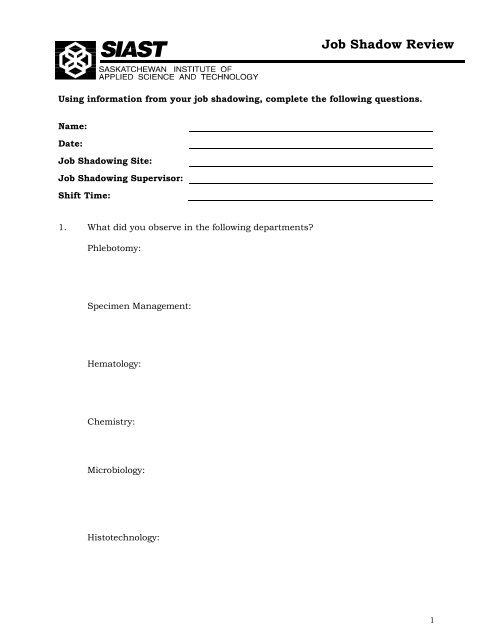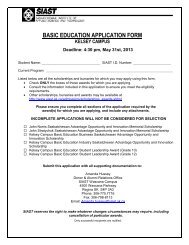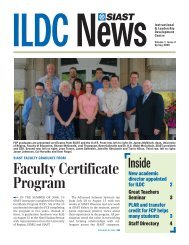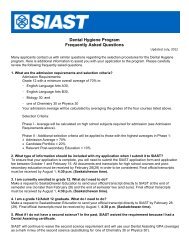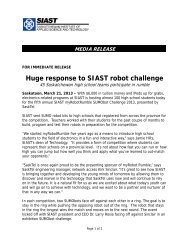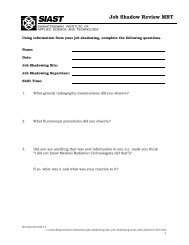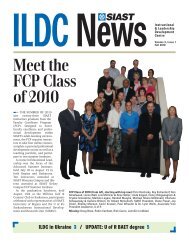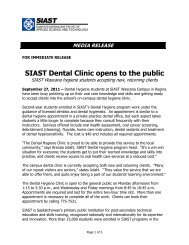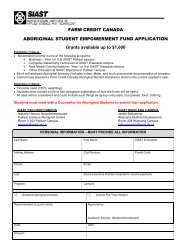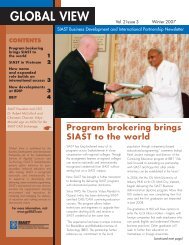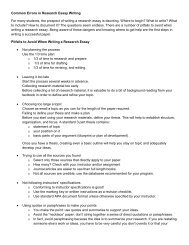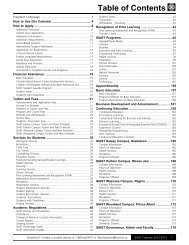Job Shadowing for Medical Laboratory Assistant (MLA)
Job Shadowing for Medical Laboratory Assistant (MLA)
Job Shadowing for Medical Laboratory Assistant (MLA)
Create successful ePaper yourself
Turn your PDF publications into a flip-book with our unique Google optimized e-Paper software.
Using in<strong>for</strong>mation from your job shadowing, complete the following questions.<br />
Name:<br />
Date:<br />
<strong>Job</strong> <strong>Shadowing</strong> Site:<br />
<strong>Job</strong> <strong>Shadowing</strong> Supervisor:<br />
Shift Time:<br />
1. What did you observe in the following departments?<br />
Phlebotomy:<br />
Specimen Management:<br />
Hematology:<br />
Chemistry:<br />
Microbiology:<br />
Histotechnology:<br />
<strong>Job</strong> Shadow Review<br />
1
2. Did you see anything that was new in<strong>for</strong>mation to you (i.e. made you think “I<br />
did not know that medical laboratory assistant (<strong>MLA</strong>) did that”)?<br />
If so what was it and what was your reaction to it?<br />
3. Based on the job shadowing experience why do you feel you will make a good<br />
<strong>Medical</strong> <strong>Laboratory</strong> <strong>Assistant</strong>?<br />
4. Please explain your definition of work ethic and professionalism?<br />
5. Based on your job shadow experience how important are work ethic and<br />
professionalism in a typical medical laboratory department?<br />
6. Please list what medical facilities you have gone to and what you have<br />
experienced to investigate your career choice. Please include dates, location and<br />
encounters.<br />
2
7. If applicable, what is the <strong>Medical</strong> <strong>Laboratory</strong> <strong>Assistant</strong> responsible <strong>for</strong> in terms<br />
of patient care and technical duties?<br />
8. Define attributes (qualities, traits or characteristics) that you observed<br />
successful and competent technologists displaying throughout the work day?<br />
9. What attributes do you possess that will assist you in to be a successful as a<br />
student in the training program?<br />
10. Describe any potential drawbacks and/or risks that may be encountered while<br />
working in this profession.<br />
11. Consider an urban hospital, a rural hospital and a private clinic. Compare the<br />
<strong>Medical</strong> <strong>Laboratory</strong> <strong>Assistant</strong>’s work schedule, volume of work, and variety.<br />
How do they differ?<br />
3
12. Describe the types of people that the <strong>Medical</strong> <strong>Laboratory</strong> <strong>Assistant</strong> may interact<br />
with as patients.<br />
13. List the various areas of the hospital or clinic the <strong>Medical</strong> <strong>Laboratory</strong> <strong>Assistant</strong><br />
may work in.<br />
When making this career choice you must first consider the demands of the program<br />
and the occupation. Besides the <strong>Job</strong> Shadow Review it is recommended you speak to<br />
current students as well as program graduates to discuss the emotional, mental and<br />
physically challenging conditions that you will experience while training and in the<br />
workplace upon completion of this program.<br />
4
<strong>Job</strong> <strong>Shadowing</strong> Objectives <strong>for</strong> <strong>Medical</strong> <strong>Laboratory</strong> <strong>Assistant</strong> (<strong>MLA</strong>)<br />
General Objectives<br />
1. To ensure the applicants are fully aware of the scope of medical<br />
laboratory tasks, both academic and day-to-day demands<br />
2. To acquaint the applicant with the medical laboratory and related<br />
terminology<br />
Specific Objectives<br />
1. To become familiar with the following medical laboratory departments.<br />
○ Phlebotomy<br />
○ Specimen Management<br />
○ Hematology<br />
○ Chemistry<br />
○ Microbiology<br />
○ Histology<br />
2. To meet departmental staff (technologists, porters, administrative and/or<br />
receptionist staff)<br />
3. To become aware of the concept of team approach to health care and how<br />
a clinical site organizes each component of the team.<br />
4. To gain an introductory understanding of medical laboratory work and<br />
the roles of various disciplines within medical technology.<br />
5. To become familiar with the blood collection process (phlebotomy) and<br />
the analysis of biological specimens.<br />
6. To gain a respect and awareness of the potential hazards associated with<br />
the collection and handling of biological specimens, and safety measures<br />
which must be implemented.<br />
Expectations of the Clinical Sites<br />
1. To provide the applicant with introductions to the department staff.<br />
2. To provide an overview of how their department fits into the health team<br />
approach of patient care.<br />
3. To provide a tour of the medical laboratory with opportunity to observe<br />
the various discipline specific areas.<br />
4. To allow the applicant to observe various tasks which would commonly<br />
be per<strong>for</strong>med by medical laboratory workers.<br />
Revised May 15/12 o:\med_diag\student orientation\job shadowing\mla_job_shadowing_<strong>for</strong>m_and_objectives 2012.doc<br />
5
5. To enable the applicant to meet with and discuss the role of the medical<br />
laboratory assistant with various staff members.<br />
6. Provide career potential and job descriptions <strong>for</strong> site.<br />
Reviewing this glossary be<strong>for</strong>e and after your job shadowing will enhance<br />
your experience.<br />
Glossary of Basic <strong>Medical</strong> <strong>Laboratory</strong> Terms<br />
Analyzer - instruments within the laboratory that separate substances (usually<br />
constituents of blood) into their constituent parts and the determination of the nature,<br />
properties, and composition of compounds.<br />
Antibodies - a protein produced by a type of white blood cell (lymphocytes) in<br />
response to bacteria, viruses, or other antigenic substances. An antibody is specific to<br />
an antigen. Each class of antibody is named <strong>for</strong> its action.<br />
Antigens - a substance, usually a protein, that causes the <strong>for</strong>mation of an antibody<br />
and reacts specifically with that antibody.<br />
Assay - the analysis of the purity or effectiveness of drugs and other biologic<br />
substances, including laboratory and clinical observations.<br />
Bacteriology - the scientific study of bacteria.<br />
Blood Bank - a unit responsible <strong>for</strong> collecting, processing and storing blood <strong>for</strong><br />
transfusion and other purposes. The blood bank is usually a subdivision of a<br />
laboratory in a hospital and is often charged with the responsibility <strong>for</strong> serologic<br />
testing<br />
Blood Typing - identification of genetically determined antigens on the surface of the<br />
red blood cell used to determine blood groups. Usually a blood bank procedure, blood<br />
typing in the first step in testing blood to be used in transfusion and is followed by<br />
cross-matching.<br />
Bone Marrow Aspirate - the fluid portion of the marrow obtained with a syringe; a<br />
suspension of blood, fat and particles of developing blood (hematopoietic) cells.<br />
Cerebrospinal Fluid (CSF) - a body fluid, normally clear and colourless, that<br />
circulates over the brain and around the spinal cord to protect them from sudden<br />
changes in pressure and provide a site <strong>for</strong> metabolic exchange of nutrients and waste.<br />
The laboratory analyzes the cells and chemical constituents of the CSF when it is<br />
withdrawn from the body to help determine the cause of illness.<br />
Clinical <strong>Laboratory</strong> - a laboratory in which tests directly related to the care of<br />
patients are per<strong>for</strong>med. Such laboratories use material obtained from patients <strong>for</strong><br />
testing, as compared with research laboratories, where animal and other sources of<br />
test material are also used.<br />
Revised May 15/12 o:\med_diag\student orientation\job shadowing\mla_job_shadowing_<strong>for</strong>m_and_objectives 2012.doc<br />
6
Coagulation - the process of trans<strong>for</strong>ming a liquid into a solid. In the laboratory it<br />
involves trans<strong>for</strong>ming the plasma in the blood into a solid. (blood clotting).<br />
Cross matching of blood - A procedure used to determine compatibility of a donor’s<br />
blood with that of a recipient after the specimens have been matched <strong>for</strong> major blood<br />
type.<br />
Culture - in the laboratory it is a test involving the cultivation of microorganisms or<br />
cells in a special growth medium.<br />
Differential (WBC) - an examination and enumeration of the distribution of<br />
leukocytes in a stained blood smear. The different kinds of white cells are counted<br />
and reported as percentages of the total examined.<br />
Electrolytes - are elements that when dissolved in fluid dissociate into ions and are<br />
able to conduct an electric current. Electrolytes differ in their concentrations in the<br />
blood plasma, body and cell fluids and affect the movements of substances between<br />
those compartments. Proper quantities of principle electrolytes and balance among<br />
them are critical to normal metabolism and function. Some of the principle<br />
electrolytes are; Sodium (Na +), Potassium (K +), Calcium (Ca ++), Magnesium (Mg ++),<br />
Chloride (Cl -), Bicarbonate (HCO3 -).<br />
Erythrocyte (Red blood cell) - the major cellular element of the blood. It is a<br />
biconcave disc about 7 micrometers in diameter that contains hemoglobin confined<br />
within a lipoid membrane. Their principle function is to transport oxygen. They<br />
originate in the long bones of adults and are released into blood circulation once they<br />
are mature.<br />
Glucose - a simple sugar found in certain foods, especially fruits, and a major source<br />
of energy occurring in human body fluids. <strong>Laboratory</strong> testing <strong>for</strong> blood levels of<br />
glucose are an important diagnostic tool in diabetes and other disorders.<br />
Immunoassay - The use of antibodies to measure hormones, proteins, and drugs.<br />
Incubator - an apparatus used in the clinical laboratory to provide a controlled<br />
environment, especially a particular temperature <strong>for</strong> the growth of microorganisms.<br />
Other environmental components, such as darkness, light, oxygen, moisture, or<br />
dryness, may also be provided.<br />
Leukocytes - a white blood cell, one of the <strong>for</strong>med elements of the circulating blood<br />
system. Five types of leukocytes have been classified. They are neutrophils,<br />
basophils, monocytes, lymphocytes and eosinophils.<br />
Microtome - a device that cuts specimens of tissue prepared in paraffin blocks into<br />
extremely thin slices <strong>for</strong> microscopic study by a surgical pathologist.<br />
Occult Blood - blood that is not apparent grossly (visibly) and appears from a nonspecific<br />
source, with obscure signs and symptoms,. It is usually detected using a<br />
chemical test. Occult blood testing is often done on stool samples from patients<br />
suspected of having GI lesions.<br />
Revised May 15/12 o:\med_diag\student orientation\job shadowing\mla_job_shadowing_<strong>for</strong>m_and_objectives 2012.doc<br />
7
Phlebotomy - the incision of a vein (usually using a needle) <strong>for</strong> the purpose of<br />
collecting of blood.<br />
Plasma - the watery straw-coloured, fluid portion of the blood in which the blood cells<br />
are suspended. Plasma is made up of water, electrolytes, proteins, glucose, fates,<br />
bilirubin and gases, and is essential <strong>for</strong> carrying the cellular elements of the blood<br />
through the microcirculation. Plasma also transports nutrients to the tissues and<br />
wastes away from them, and works to maintain acid-base balance of the body.<br />
Platelets - the smallest cells in the blood and are essential <strong>for</strong> the coagulation of blood<br />
and to maintain hemostasis.<br />
Sample (patient) - Prepared from a patient specimen and used to obtain in<strong>for</strong>mation<br />
by means of a specific laboratory test.<br />
Serum - the clear, thin, and sticky fluid portion of the blood that remains after<br />
coagulation. Serum contains no blood cells, platelets or fibrinogen.<br />
Specimen (patient) - A volume of whole blood (or other body fluid/product),<br />
appropriately collected, transported, and processed to provide a sample <strong>for</strong> the<br />
purpose of per<strong>for</strong>ming one or more laboratory tests.<br />
Stain - a pigment, dye or substance used to impart color to microscopic objects or<br />
tissues to facilitate their examination and identification.<br />
Stat - abbreviation <strong>for</strong> the Latin work statim, “immediately”.<br />
Urinalysis - a physical microscopic and chemical examination of urine.<br />
Tissue Typing - a systemized series of tests to evaluate the intra-species compatibility<br />
of tissues from a donor and a recipient be<strong>for</strong>e transplantation. Typing is accomplished<br />
by identifying and comparing a large series of human leukocyte antigens (HLA) in the<br />
cells of the body.<br />
Virology - the study of viruses and viral diseases.<br />
24 hour urine - a collection of all the urine voided from a patient over a 24 hour<br />
period.<br />
24/7 shift work 365 - a laboratory that operates 24 hours a day, 7 days a week, 365<br />
days a year.<br />
Bibliography<br />
Andersen, Kenneth & Andersen, Lois & Glanze, Walter. 1994 Mosby Inc.,<br />
Mosby’s <strong>Medical</strong>, Nursing & Allied Health Dictionary 4 th Edition.<br />
Revised May 15/12 o:\med_diag\student orientation\job shadowing\mla_job_shadowing_<strong>for</strong>m_and_objectives 2012.doc<br />
8
A <strong>Medical</strong> <strong>Laboratory</strong> <strong>Assistant</strong> (<strong>MLA</strong>) is trained in some of the<br />
following medical laboratory departments (a brief description of<br />
each department is included):<br />
Clinical Chemistry<br />
In this department the chemical constituents of the blood, urine and other<br />
body fluids are analyzed. Determination of the levels of substance (e.g.<br />
Cholesterol or glucose) is critical in the diagnosis and treatment of medical<br />
conditions such as heart disease and diabetes. Numerous other substances,<br />
including drugs are tested in order to assist the physician in the diagnosis,<br />
treatment and monitoring of many other clinical conditions. Analytical<br />
techniques use specialized equipment, incorporating photometric,<br />
electrochemical and other methods of measurement to detect, very accurately,<br />
small quantities of the analyte.<br />
Hematology<br />
In this department the cellular components of blood and its clotting<br />
mechanisms are analyzed. Through cell counts and microscopic examination<br />
of red blood cells and white blood cells, the technologist assists in identifying<br />
specific disease conditions such as anemia and leukemia. For patients who<br />
have disorders that cause prolonged bleeding or cause the blood to clot too<br />
quickly, coagulation studies assist the physician in prescribing the correct<br />
therapy (e.g. Anticoagulants <strong>for</strong> heart attack or stroke victims).<br />
Histotechnology<br />
In this department, every tissue that is removed from the human body through<br />
biopsy, surgery or autopsy is processed and analyzed. For some biopsies and<br />
surgeries, the surgeon may need to know immediately if a lump or tumor is<br />
malignant or benign. In most other cases, this tissue will be examined to<br />
determine the cause of the disease or, <strong>for</strong> autopsies, the cause of death. The<br />
<strong>MLA</strong> processes the tissues <strong>for</strong> microscopic examination by the pathologist.<br />
Microbiology<br />
In this department the types of microorganisms that are causing diseases or<br />
infections in patients are identified. This is done using special culture<br />
techniques, biochemical tests, and microscopic examination. The antibiotic(s)<br />
that would be effective in treating the infection are also identified.<br />
Specimen Management<br />
In this sub-department the <strong>MLA</strong>, along with <strong>Medical</strong> <strong>Laboratory</strong> Technologists,<br />
receive patient specimens from collection centres, log them into the laboratory<br />
system to provide specimen tracking and prepare the samples <strong>for</strong> testing in the<br />
various laboratory departments.<br />
Revised May 15/12 o:\med_diag\student orientation\job shadowing\mla_job_shadowing_<strong>for</strong>m_and_objectives 2012.doc<br />
9
Students should be com<strong>for</strong>table with per<strong>for</strong>ming the following<br />
mathematical functions.<br />
Unit Conversion<br />
1. Express 50ug/mL as mg/L.<br />
Reagent Preparation<br />
1. Determine how many grams of KCl must be weighed to prepare 500 mL<br />
of a 2.5 molar KCl solution. (Molarity)<br />
2. Determine how many grams of NaCl must be weighed to prepare 2 L of a<br />
0.85% w/v NaCl solution (saline). (Percent Solutions)<br />
3. Determine how many mL of a 50 mmol/L Glucose stock standard are<br />
required to prepare 100 mL of a 5 mmol/L Glucose working standard.<br />
(V1C1=V2C2)<br />
Dilutions<br />
1. Determine how many mL of diluent are required to make a 1 in 10<br />
dilution of 2 mL of patient serum.<br />
2. Determine the concentration of glucose in a patient’s sample (serum) that<br />
was diluted 1 in 5 prior to testing.<br />
Diluted glucose result = 3.5 mmol/L<br />
Revised May 15/12 o:\med_diag\student orientation\job shadowing\mla_job_shadowing_<strong>for</strong>m_and_objectives 2012.doc<br />
10


